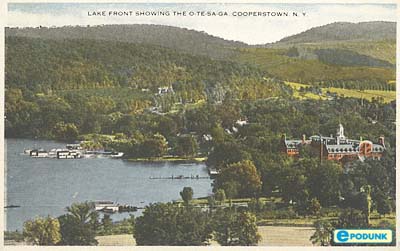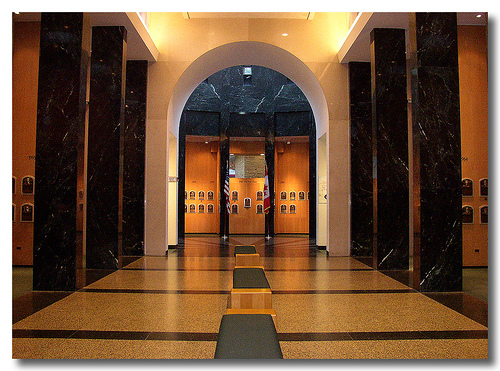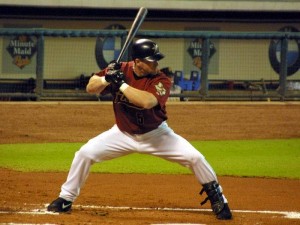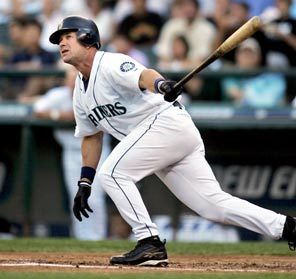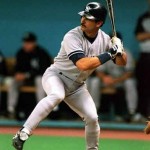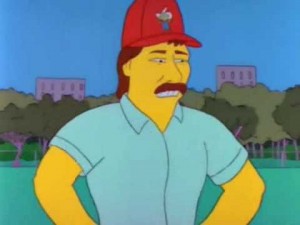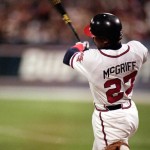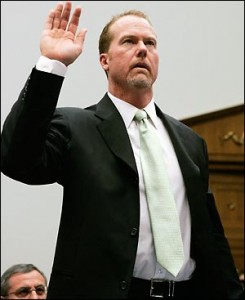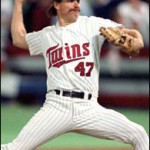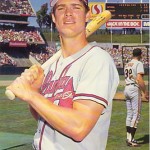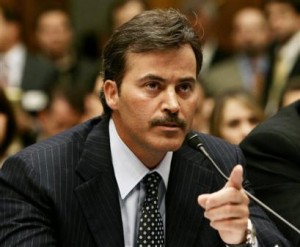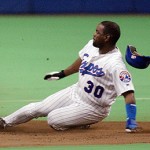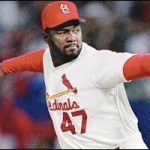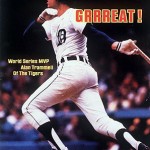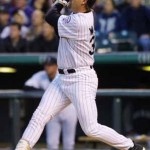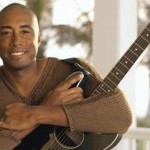The NFL Hall of Fame is in Canton. The museum is rather fun, and the hall enshrining the individual busts of players past and present is appropriately filled with dim lighting. It’s like an old gallery of ancient Rome, if all Romans were hulked-out on ‘roids, overweight, or just downright psychotic. (Maybe not too big a stretch to think about.) The Naismith Basketball Memorial Hall of Fame is somewhere in Massachusetts, and should receive a great deal of credit for enshrining, well, everybody. That being said, the Hall itself leaves much to be desired. I hear that the NHL has a Hall of Fame, where they can someday lay the carcass of the NHL when the sport’s owners have finished pilfering the body for vital organs and valuables. And let’s not get started on golf.
In all of American sports, there is only one Hall of Fame that truly weighs heavily over the entire sport that it is devoted to, a grand building situated in an idyllic town in upstate New York that can only be reached by driving through rolling hills and leafy forests. It is one hour from any major airport and features one massive hotel; there are more than enough accommodations in small cabins and bed and breakfasts surrounding the beautiful lake, as well as wide array of museums and small town charm. (I once took part in a peaceful protest against the Iraq War out front of the local post office!)
And then there’s the Hall of Fame itself. A beautiful building, the museum draws hundreds of thousands of tourists annually to oversee the game’s accomplishments. The Hall of Plaques is streamlined, lit by natural lighting, and showcases the multitude of heroes that the game has had to offer. There are pre-1900’s stars mingled with the stars of today, Negro League players finally integrated with the stars of the first half of the century who shunned their very existence for so long.
In the sport itself, there is continual talk of who will be a future Hall of Famer, as though their worth on the field can only be validated by their eventual placement alongside the greats of the game. Performances and statistics are intensely scrutinized on a daily basis by hordes of fans willing to prove or disprove how well a current player stacks up against their idol of choice. It is a ruthless game, filled with hyenas and jackals, and there is no Hall of Fame more vivaciously and more fiercely defended that the one plopped down in the middle of Cooperstown, NY.
And the fight against it is about to get a whole lot more bitter.
The 2013 Hall of Fame ballot was recently released, featuring a small host of first timers up for the vote who have met the qualifications to be included alongside returning players. The rules for enshrinement are simple.
1) To appear on the ballot, a player must have been retired for at least five consecutive years. (Or in the case of Rickey Henderson, not playing professional baseball; the man couldn’t stay away from the game, turning to semi-pro teams such as the Newark Bears.)
2) To gain enshrinement into the Hall, you must receive 75% of the votes during one balloting period. (To be a ‘first-ballot’ candidate, or to get in on your first try, is the highest honor the Hall can afford.)
3) The ballot is voted on by the BBWAA (Baseball Writer’s Association of America), who are given a set of criteria to consider by the Hall of Fame. (More on this later.)
4) Players who do not receive 75% of the vote are then split into groups: those who received less than 5% of the vote, and are subsequently removed from the ballot; and those who receive between 5% and 75% of the vote, who are kept on the ballot for the next year…
5) …with ONE stipulation, being that a player can only appear on fifteen ballots within a fifteen year time frame before being removed forever. (You’ve had your chance, in other words, and thank you for playing.)
(That last stipulation has little effect, however, because of the Veteran’s Committee, which has rectified the oversights of the BBWAA over the years. That’s how Ron Santo finally got into the Hall of Fame last year, as did other players such as Bill Mazeroski. That committee breaks itself down into three groups at the moment, including a Pre-Integration Ballot this year that has already inducted former Yankees owner Jacob Ruppert, 19th century catcher Deacon White, and turn-of-the-century umpire Hank O’Day.)
Now, with all of the above criteria considered, let it be said that the Hall is bracing for a turbulent five year period, one in which the ballot will overflow with some of the greatest and most controversial names to play the game. At least, in recent memory. (never mind that the Hall has already enshrined former members of the Ku Klux Klan. That’s all in the past!) The Steroid Era has already placed several candidates on the ballot for consideration, who are meeting initial resistance from the Writers seeking to protect the Hall’s reputation. As mentioned before, baseball is very protective of its records, and there is a great deal of collected resentment among players suspected of ‘juicing’ in order to become greater players, as though they have cheated the game.
This is in spite of quotes such as the following liberally populating the rough and tumble history of baseball: “If you’re not cheating, you’re not trying.” Rogers Hornsby, Hall of Famer, and potentially the greatest 2nd Baseman to ever play the game, and one mean son of a bitch.
This is also a sport that refused the right of black players to play alongside whites until Jackie Robinson broke the color barrier in 1947, where he was immediately subjected to a brutal period of abuse unlike anything any modern athlete can or will ever experience. (Although if a homosexual player were to come out, the experience might be similar, but that’s a story for another time.)
But that’s not what we’re here to do. My job is to break down the ballot, examine who is on it, and figure out who is likely to make the cut this year, who is deserving of the honor, and who falls just short of enshrinement.
Picking the selectees of the Hall of Fame ballot is not like forecasting the Oscars or MVP races of any given sport. I suspect even Nate Silver would have problems analyzing the torrents of conflicting data coming from the Writers. The election process is highly based upon who a writer may have seen play and to whom they lack exposure to. One writer might not like one guy, while he might feel that another guy is underrepresented. There are so many unquantifiable factors that go into a final ballot that it is nigh impossible to accurately project every single candidate. And even when you have a sure fire winner like Cal Ripkin Jr., it’s hard to predict that the only ballots he will not be named on are ballots that are turned in blank to protest the Steroid Era. (This is another reason why there has never been a unanimous inductee into the Hall of Fame. Nope, not even Babe Ruth; some writers of the time absolutely hated the guy.)
The job of forecasting the ballot should get harder in years to come because, as I mentioned before, we’re facing a glut of players to come onto the ballot:
Next Year (2014): Jim Edmonds, Tom Glavine, Jeff Kent, Greg Maddux, Mike Mussina, Frank Thomas.
2015: Carlos Delgado, Nomar Garciaparra, Randy Johnson, Pedro Martinez, Gary Sheffield, John Smoltz.
2016: Ken Griffey Jr., Trevor Hoffman, Billy Wagner.
2017: Vladimir Guerrero, Jorge Posada, Manny Ramirez, Ivan Rodriguez.
And that’s before telling you who’s on the ballot this year!
So, without further ado, I present to you the candidates for election in the Baseball Hall of Fame Class of 2013.
(Note: Because this is a huge ballot and breaking down the players takes up a sizeable amount of space, I’m breaking this into three columns. The first will deal with players who have been on the ballot for some time now. The second will break down the considerable number of players on the ballot for the first time. The third will look at active players and assess which are most deserving of potential enshrinement. You can probably expect a reactionary column in response to the final results of the Hall vote, where I rant and rave over who makes it in and who gets the shaft. As always, feel free to dispute my thoughts and feelings; I make no guarantees of impartiality towards these players, many of whom I have grown up watching.)
BALLOT HOLDOVERS
Jeff Bagwell (3rd Year on Ballot)
| YRS | AVG | G | AB | R | H | 2B | 3B | HR | RBI | BB | SO | SB | OBP | SLG |
| 1991-2005 | .297 | 2150 | 7797 | 1517 | 2314 | 488 | 32 | 449 | 1529 | 1401 | 1558 | 202 | .408 | .540 |
(The above stat boxes are lovingly ripped from the Hall of Fame individual player’s profiles as a means to better showcase the player’s abilities and/or shortcomings.)
Bagwell was a star for the Houston Astros for much of his career, and in his third year looks to build off of his 56% vote totals from last year. Having gained a significant proportion of votes last year, Bagwell looks like he’s trending towards inevitable induction. The case for him is that he was a dominant run producer in the league for much of his prime, winning the Rookie of the Year in 1991 and the unanimous MVP in the strike-shortened 1994 season, while finishing in the top-10 of MVP voting five other times. What typically makes a candidate a sure-fire Hall of Famer (given recent experience) is if you can look at a player and make a definitive case that they not only excelled at their given position, but were the best player at that spot for a period ranging from 4-6 years, with bonus points for longevity. In this instance, Bagwell was one of the best 1st basemen of the 90’s, and his raw numbers from 1994 to 2001 certainly point to his overall command of the position.
There are two factors working against Mr. Bagwell, however. The first is that he lacks the round numbers that Hall of Fame voters typically thirst for; 3,000 hits, 500 home runs, and 300 pitching wins have long been considered safe numbers for election. (They’ve also somewhat been thrown out of late by voters, but we’ll get to that too.) In this instance, Bagwell suffers because of a plague of injuries that struck in the early part of the 2000’s, forcing his premature retirement from baseball. If he has healthier seasons from 2003-2005 and plays an additional season or two, it’s not inconceivable to see him crack 500 home runs, thus “ensuring” himself of election. (Which just goes to show how silly these round numbers are with regards to some players.) The second factor working against Bagwell, to an unknown degree, is that he is an admitted user of androstenedione, a drug that metabolizes into testosterone when ingested (thus a form of stimulant designed to gain a competitive advantage.) TO HIS CREDIT, the use of andro was not banned until 2004 and Bagwell openly admitted to using it. Consequently, his use of a performance enhancement is weighed less heavily than it would be for some modern players we’ll be getting to in the next column.
In my honest opinion, I don’t see Bagwell cracking the 75% threshold this year, though I do see him reaching the mid-60’s. There might be a push by voters to induct him alongside his longtime teammate Craig Biggio, which is the only scenario I see for Bagwell getting elected this year; jumps in vote totals like that are somewhat unheard of. Verdict: Slight chance, but wait ‘til next year.
Edgar Martinez (4th Year on Ballot)
| YRS | AVG | G | AB | R | H | 2B | 3B | HR | RBI | BB | SO | SB | OBP | SLG |
| 1987-2004 | .312 | 2055 | 7213 | 1219 | 2247 | 514 | 15 | 309 | 1261 | 1283 | 1202 | 49 | .418 | .515 |
Edgar Martinez suffers from the fact that he played exclusively at DH, never taking the field as a defender. While there is movement among players gaining admittance for their hitting accomplishments alone (I’m looking at you, Paul Moliter…), to do so would require a player to absolutely dominate at hitting the baseball. (We’ll see this with Frank Thomas next year, I’m sure.) Edgar was a consummate hitting professional; after watching clips of his hitting practices, I must admit that I’ve never seen a modern athlete work so hard with such single minded focus to perfect the art of hitting a baseball. (Not since Ted Williams, anyways.) Now, look at this: Edgar is one of only ten players ever with 300 homers, 500 doubles, a lifetime .300 batting average, .400 OBP, and .500 slugging percentage. Other players who have achieved that? Stan Musial, Babe Ruth, Mel Ott, Frank Thomas, Chipper Jones, Ted Williams, Lou Gehrig, Jimmy Foxx, and Manny Ramirez (oops). In short, elite company; he deserves to be in. With that being said, Edgar received only 36.5% of the vote last year, and has some serious work to do to catch up. I get the feeling that he’ll be more likely to be elected by his 11th or 12th ballot, but not anytime soon with the current glut of players. Verdict: Deserves it, but not likely.
Don Mattingly (13th Year on Ballot)
| YRS | AVG | G | AB | R | H | 2B | 3B | HR | RBI | BB | SO | SB | OBP | SLG |
| 1982-95 | .307 | 1785 | 7003 | 1007 | 2153 | 442 | 20 | 222 | 1099 | 588 | 444 | 14 | .358 | .471 |
Mr. Mattingly, currently managing the L.A. Dodgers, was a very good hitter. As a captain of the Yankees, he was certainly very popular. However, this is another case where injuries curtailed his career, preventing him from compiling truly gaudy numbers. His numbers are certainly good, he did win an MVP, and was a 9-time Gold Glove winner at 1st base. With that being said, he didn’t have the typical power associated with a first baseman, and he lacks the postseason credentials that a Jorge Posada might have down the road. Without the grand numbers or postseason credentials to back him up, Mattingly falls into the nether world of “very good” but not “Hall of Famer’s.” Verdict: No.
(Sidenote: It was hard not to include the picture from the Simpson’s episode “Homer at the Bat”, so I did it. You’re welcome.)
Fred McGriff (4th Year on Ballot)
| YRS | AVG | G | AB | R | H | 2B | 3B | HR | RBI | BB | SO | SB | OBP | SLG |
| 1986-2004 | .284 | 2460 | 8757 | 1349 | 2490 | 441 | 24 | 493 | 1550 | 1305 | 1882 | 72 | .377 | .509 |
Crime Dog! I was a big fan of Fred McGriff growing up; he was a marvel of consistency who year-in, year-out would put up 30 home runs, 100 RBI’s, a high number of hits, get on base, and man 1st base with nary a complain. Unfortunately, I was one of roughly eight total fans across the country of the Crime Dog. Overshadowed by other hitters during the Steroid Era, McGriff was an unfortunate victim of not being glamorous enough and not hitting nearly enough home runs. He also bounced from team to team in the free agent market as teams sought out more powerful first basemen along the lines of a Mark McGuire, Albert Pujols, etc. By the end of his career, he was forced to the likes of the Devil Rays (back when they were terrible) and the also-ran Chicago Cubs to try and crack the 500 home run plateau (back when it meant something). Alas, he finishes tied with Lou Gehrig for home run totals, falling just short of solid round numbers. In addition, while he was a consistent hitter, he was seldom a great hitter. I love me some Crime Dog, but I fear that he’ll go the way of Dale Murphy and eventually fall off the ballot. Then again, he may be the beneficiary of a Jim Rice-style retrospective where voters finally recognize him over time, enshrining him later on in the balloting process. I’d be there if he gets inducted! Verdict: Highway Robbery, but no.
Mark McGwire (7th Year on Ballot)
| YRS | AVG | G | AB | R | H | 2B | 3B | HR | RBI | BB | SO | SB | OBP | SLG |
| 1986-2001 | .263 | 1874 | 6187 | 1167 | 1626 | 252 | 6 | 583 | 1414 | 1317 | 1596 | 12 | .394 | .588 |
Ah, the first of the Steroid Era crew. The recipient of 19.5% during his last time on the ballot, it seems as though Mark McGwire will never make it in on the Writer’s Ballot. An admitted steroid user, he has been punished for having the audacity to break Roger Maris’ single season home run record in 1998 with an astonishing 70 home runs (shortly broken thereafter by one Barry Lamar Bonds, but we’ll get to that soon, too.) by being kept from enshrinement with ridiculously low vote totals for years now.
Here’s where I make some arguments for McGwire: The Hall of Fame is filled with scumbags, racists, cheats, jerks, adulterers, rapists, and assorted other n’er-do-wells that go far beyond men with a gambling problem (sore spot, sorry) or men who were actively trying to better themselves to play to win the game. Why is it that steroid users are being punished for doing something that was actively accepted within every major league clubhouse, while pronounced cheaters like Gaylord Perry are given the honor of joining the Hall of Fame, even celebrated for their deeds? Shoot, Roger Maris isn’t even in the Hall of Fame. McGwire was one of the most feared sluggers of the 1990’s. It takes a serious amount of work to hit a baseball; not everyone can do it? Why take it out on him?
Here’s where I make some arguments against McGwire: He had a low batting average; he did one thing well (hit home runs); his career hit total was lacking; he struck out too much; by the end of his career, he was essentially playing out the string; his prime was split into two categories; he was only a good player because he used steroids.
See, it’s fine that players cheat to win the game. Baseball is a sport where if you’re not seeking to gain an advantage, you really aren’t trying (that quote still rings true). Steroids, however, create an uneven playing field. There are hundreds of instances where some poor kid in the minors missed a shot at the big leagues because another guy on his team used juice to throw a baseball a few mph faster than he could before, or because another guy suddenly turned his pop flies into home runs. These players robbed hundreds of other players of the chance to make it into the majors, and the ones who thrived made (in the eyes of the writers) unfair assaults on the most hallowed records of the game. Baseball, as I said before, is a sport that takes its numbers seriously, and the writers who elect the players take the character clause of the Hall of Fame very seriously. Since 1944, writers have been instructed to take players into account “on the basis of playing ability, sportsmanship, character, their contribution to the teams on which they played and to baseball in general.” The character of some of these players, caught red-handed at times using steroids, is what is on trial here. In this case, I feel that McGwire should get some credit for admitting and apologizing for his use of steroids, but in the eyes of the writers, the weight of the sin outweighs the guilt of the sinner. It would be easier to cast McGwire aside if his numbers were universally mediocre, but the home run total stands out like a sore thumb in the eye of every voter. Verdict: No.
Jack Morris (14th Year on Ballot)
| YRS | W-L | ERA | G | GS | CG | SHO | SV | IP | H | BB | SO |
| 1977-94 | 254-186 | 3.90 | 549 | 527 | 175 | 28 | 0 | 3824 | 3567 | 1390 | 2478 |
There is a compelling question that has been asked in the wake of Bert Blyleven, Bruce Sutter, and Jim Rice being elected later in the voting process of what exactly has changed about the candidates over time that makes them worthier of election now than when they first appeared on the ballot. The answer? Intense lobbying on the parts of some (Blyleven), a re-evaluation of another’s career (Rice), or the simple fact that the writers feel they need to elect somebody in a given year. (Sutter? Sutter.) And here is where we present Jack Morris, he of the most wins during the 1980’s, a reputation as an ace you’d want on the mound if you were playing a game you had to win, and that sterling 1991 Game 7, where he pitched ten gritty innings of shut-out ball for the World Series Win.
Enough has been said about his merits and accomplishments across the internet. Last year, he garnered 66.7% of the vote, a threshold that all but ensures enshrinement in the following years. Morris is also lucky that he’s going up against steroid candidates, players the writers might feel uncomfortable about letting in on their first ballot. He’s getting in, no if’s, and’s, or but’s. Verdict: Yes. And you can quote me on that.
Dale Murphy (15th Year on Ballot)
| YRS | AVG | G | AB | R | H | 2B | 3B | HR | RBI | BB | SO | SB | OBP | SLG |
| 1976-93 | .265 | 2180 | 7960 | 1197 | 2111 | 350 | 39 | 398 | 1266 | 986 | 1748 | 161 | .346 | .469 |
His prime in the early 80’s was good, but the eight years after and his early years were considerably lacking. There’s a reason he only garnered 14.5% of the vote last year. I doubt the Veteran’s Committee will do anything about him either. Verdict: No.
Rafael Palmeiro (3rd Year on Ballot)
| YRS | AVG | G | AB | R | H | 2B | 3B | HR | RBI | BB | SO | SB | OBP | SLG |
| 1986-2005 | .288 | 2831 | 10472 | 1663 | 3020 | 585 | 38 | 569 | 1835 | 1353 | 1348 | 97 | .371 | .515 |
Here we have a man who testified before Congress that “[he had] never taken steroids. Period.” Six months later, after garnering his 3,000th hit, he tested positive for steroids. And threw his teammates under the bus trying to protest that “he was framed” I tell ya, framed! This is made easier by the fact that he was never that inspiring of a player in the first place. Had he not tested positive? He’d be a surefire lock; 3,000 hits and 500 home runs are the kind of round numbers that put you in the company of Willie Mays. Which makes his having used steroids all the more unfortunate. Remember that character clause? Palmeiro fails. Last year, he received 12.6%. That might drop this year. Verdict: Not a snowball’s chance in hell.
Tim Raines (6th Year on Ballot)
| YRS | AVG | G | AB | R | H | 2B | 3B | HR | RBI | BB | SO | SB | OBP | SLG |
| 1979-99 | .294 | 2502 | 8872 | 1571 | 2605 | 430 | 113 | 170 | 980 | 1330 | 966 | 808 | .385 | .425 |
Tim Raines was the second best leadoff hitter of his time. However, he played against Rickey Henderson, which shunted him aside. His numbers are fantastic, and he has a case as one of the best leadoff hitters of all time. His overall numbers are decent, though for a leadoff hitter, your typical voter would like to see his hit total and number of doubles a bit higher than they actually are. I personally think he deserves to be elected, an opinion I share with many others. His vote total of 48.7% last year continues to climb, so I think that in years to come, he will be elected. However, he’s got some climbing to do to convince a further 25% of the electorate. With all of the players to come, he falls into the same trap as Edgar does, of being in the wrong place at the wrong time. Verdict: Deserving, but no.
Lee Smith (11th Year on Ballot)
| YRS | W-L | ERA | G | GS | CG | SHO | SV | IP | H | BB | SO |
| 1980-97 | 71-92 | 3.03 | 1022 | 6 | 0 | 0 | 478 | 1289.1 | 1133 | 486 | 1251 |
The first modern closer, who would pitch the 9th inning to garner a save, and the 9th inning exclusively. He used to hold the record for career saves before that was shattered by Trevor Hoffman and Mariano Rivera, arguably two of the greatest closers of all time in terms of sheer dominance. Smith’s vote total has been climbing, and currently stands at 50.6%. I just don’t see him surpassing that and gaining admission. He might be a Veteran’s Committee project in the future, but I really doubt that. Sleeping in the clubhouse during games kind of works against you in the long run. Verdict: No.
Alan Trammell (12th Year on Ballot)
| YRS | AVG | G | AB | R | H | 2B | 3B | HR | RBI | BB | SO | SB | OBP | SLG |
| 1977-96 | .285 | 2293 | 8288 | 1231 | 2365 | 412 | 55 | 185 | 1003 | 850 | 874 | 236 | .352 | .415 |
He was a winner and one of the best shortstops of his time, sort of a poor man’s Barry Larkin. And Larkin got in, right? Trammell’s WAR (A sabermetric stat called Wins Above Replacement Player, or how much better a player is than your average player just called up from the minor’s) is tied with Larkin at 67.1, and his WAR7 (his best seven seasons) is actually better than Larkin’s at 43.3. He’s clearly good, and fits in. I just don’t see his election being likely, as Trammell is not as flashy a character as other players of his time were. He’s most likely heading for a Veteran’s Committee showdown, someday. Verdict: No.
Larry Walker (3rd Year on Ballot)
| YRS | AVG | G | AB | R | H | 2B | 3B | HR | RBI | BB | SO | SB | OBP | SLG |
| 1989-2005 | .313 | 1988 | 6907 | 1355 | 2160 | 471 | 62 | 383 | 1311 | 913 | 1231 | 230 | .400 | .565 |
Larry Walker is not so much a victim of the Steroid Era as he is a victim of the Coors’ Field effect (playing in high altitudes in Colorado spiked his numbers to a greater point than they would normally be). Which is unfortunate, because he was just as good a hitter on the road as he was in Colorado, hitting .314/.410/.592 in his peak years of 1997-1999 while on the road. Those are the numbers of a masher, which Walker was. His career was somewhat shortened by injuries, but his WAR of 69.7 is higher than anyone else’s on last year’s ballot (except for Jeff Bagwell, who will be in sooner rather than later.) I don’t see Larry Walker getting in anytime soon, but I see him as a prime candidate for a turnaround candidacy in years to come. I also see him getting buried by the wave of players over the next five years. Verdict: No, and his future is hazy.
Bernie Williams (2nd Year on Ballot)
| YRS | AVG | G | AB | R | H | 2B | 3B | HR | RBI | BB | SO | SB | OBP | SLG |
| 1991-2006 | .297 | 2076 | 7869 | 1366 | 2336 | 449 | 55 | 287 | 1257 | 1069 | 1212 | 147 | .381 | .477 |
One of the centerpieces of the late 90’s Yankee dynasty, Williams is the lone holdover from a particularly weak Hall of Fame class last year (Vinny Castilla? Javy Lopez? Eric Young? ERIC YOUNG?!). While his regular season numbers are only so-so, his postseason numbers are what keep him in the discussion, ranking second in most major categories and 1st in postseason RBI’s. Those postseason numbers, I should mention, are largely the benefit of the expansion to include divisional series in 1995, as well as him benefitting from over-exposure because he was playing for the freaking New York Yankees. He’s a wonderful guitarist, and certainly a hero in New York who should never have to buy a beer in the Big Apple. That’s why the Yankees have their own monument to their greats out in center field, though. So they can recognize their own. He’s a very good player, but not a Hall of Famer; he’ll fall off the ballot this year, having received only 9% of the vote last year. This year should knock him off completely. Verdict: No.
RECAP
That leaves Jack Morris as our lone inductee from the holdovers, with small potential out there for Jeff Bagwell, and future candidacies for Edgar Martinez, Tim Raines, Larry Walker, and (crossing my fingers here) Fred McGriff. Keep in mind that a voter can only vote for ten players at a time.
Now, stay tuned for the newcomers to the ballot.

